Nutrition for cycling: nail the basics with our guide on what you need and where to get it
If you want the best output from your legs, you need the best input in terms of your fuelling – but how exactly?
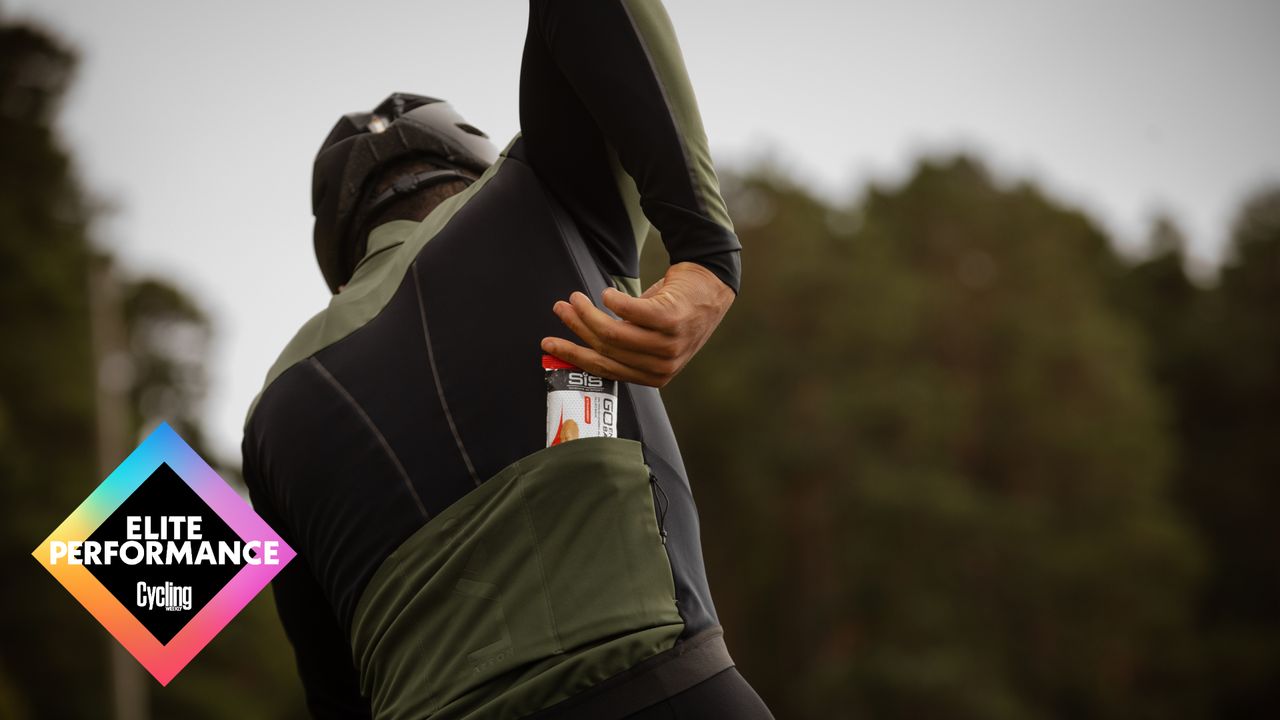
Food and fluid provide the energy required by every function of the body and, for endurance cyclists, our two major fuel sources are carbohydrates and fats. The average human stores over 100,000 calories worth of energy in fat, and a much smaller reserve of carbs – around 2,000 calories. Let’s not forget the importance of hydration, with humans being 60-70 per cent water; even bone is one-third H2O.
Here, we’ll take you through a quick guide on how much you should consume on rides of varying lengths. We’ve then got a deep dive on everything you need to know about carbohydrates, hydration, on the bike fuelling, post ride nutrition, recipes, and a host of other topics. So sit back and get familiar with the essentials of cycling nutrition.
Quick guide to fuelling
CW’s quick fuelling guidelines for low to medium-intensity training rides:
<1hr ride: No on-bike fuel needed
1-2hr ride: 20g carbs per hour
2-3hr ride: 30g carbs per hour
>3hr ride: 40g carbs per hour
Get The Leadout Newsletter
The latest race content, interviews, features, reviews and expert buying guides, direct to your inbox!
For higher-intensity training and races, sports nutritionist Dr Marc Fell’s research offers the following guidance:
<1hr session or race: No on-bike fuel needed
60-90min session or race: 30g carbs per hour
90min-3hr session or race:45-60g carbs per hour
>3hr session or race: 90g carbs per hour
*These guidelines take for granted that 1) your gut can tolerate the carbohydrates; and 2) you had sufficient carbohydrate in your diet prior to the session (i.e. glycogen stores are full).
Carbohydrates: the body’s fuel supply for cycling
If we have so much energy available in fat, why do we need carbs in our diet? What about low-carb training? To cut a long story short, it’s easier and faster for the body to extract energy from carbohydrates than from fat. This is why carbs are king, even if we only store them in modest amounts. No pro in the peloton performs without an abundance of carbohydrates on board.
Marc Fell, a sports nutritionist at Liverpool John Moores University, explains the interaction between carbs and fats for fuel: “At low intensity, you don’t need a lot of carbs. But carbohydrate is a more efficient fuel than fat. For the average cyclist, there is a crossover point where carbohydrate metabolism begins to take over from fat metabolism – at around 70 to 75 per cent of your VO2max.” This is not on/off but more like a dimmer switch – the harder you work, the more your body turns towards carbohydrates as its main fuel.
Above FTP (around 85 per cent of VO2max), you’re burning almost exclusively carbohydrates. When demand is so high, it’s easier for your body to extract energy from simpler carbohydrates (i.e. sugars) than complex ones. This is why the pros prefer gels to cheese sandwiches in races. Whereas at lower intensities, such as your leisurely Sunday ride, a cheese sandwich might be the better choice than even the best energy gels.
“The key for fuelling,” Fell continues, “is to match the energy supply to the energy demand. The requirements for energy in training and racing will vary greatly depending on the goal of the session, the intensity and the duration.”
Since each training session has unique fuel demands, it makes sense to tailor your fuelling plan accordingly, which is the idea behind the mantra ‘fuelling for the work required’ - we discuss how best to go about matching what you eat to your training here.
As Fell explains, the central concept in fuelling is homeostasis – the human body likes to be stable. When we train, we upset the balance, often accruing a deficit. To optimise performance, we need to match refuelling and rehydration as closely as possible to what we are using (or used) during training. When we under-fuel or under-hydrate, we put additional stress on the body, forcing it into ‘protect and conserve’ mode. Even if you’re trying to lose weight while cycling, you should fully fuel your training and racing.
Hydration: make sure you drink enough to perform at your best
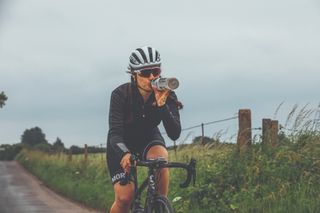
When we train, we excrete water (and salt) through our sweat, which helps to keep our body temperature stable.
In addition to drinking 1.5-2 litres of water across the day, cyclists should ideally be drinking additional fluid to match any loss during riding. An easy way to work out your need is, is to weigh yourself pre and post-ride. For each kilo you have lost, you require an additional litre of water, so if a 60-minute ride leaves you 0.5kg lighter then you just require an extra 500ml of fluid in the diet to rebalance things.
With just two per cent dehydration resulting in a significant reduction in performance, it’s worth paying attention to this statistic. It’s such a small simple step, but it will make a huge difference.
“When we talk about hydration, what we are really concerned about is water and salt losses through sweat,” explains Dr Allen Lim, founder of Skratch Labs. He is a cycling coach and sports physiologist who has been working with professional cyclists since the early 2000s. When it comes to hydration in sport, why do we hear so many differing theories?
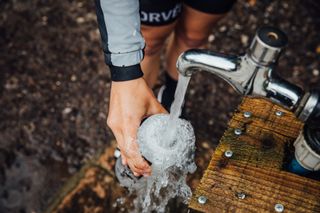
“There are many factors that influence dehydration; the science is not clearcut,” responds Lim. “How much people sweat, and how much salt is in sweat, varies from person to person. When cycling in hot weather, to stay hydrated you might need up to two litres per hour, depending on your body size and intensity. The composition and saltiness of our sweat is partly determined by our individual genetics.”
We’re saltier beings than you might expect: blood contains around 3,000mg sodium per litre. “That’s about the same as miso soup,” jokes Lim. “An individual can have anywhere from 400mg to 2,000mg sodium per litre of sweat. This is why many of the best energy drinks settle on 1,000mg of salt per litre.”
Asked about the dangers of over-hydrating, Lim advises: “There’s a lot of fear-mongering in marketing. Hydration is not as complicated as it’s presented as being. The main concern of overhydration is that the amount of electrolytes in your body become too diluted [hyponatremia] – but this is extremely unlikely, provided you drink to thirst.”
What does this mean in practice? “Drinking plain water is fine for the first few hours of exercise,” advises Lim. “Beyond that, by adding salts to our fluid, it helps to prolong performance because it means you worry less about electrolyte imbalance.”
Fuelling on the bike
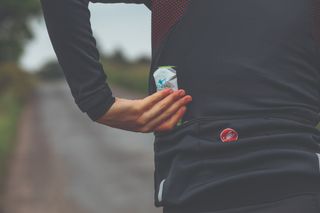
Having a fuelling and hydration strategy is one thing; successfully executing it is an entirely different matter. We asked Heidi Blunden from Parallel Cycle Coaching how she helps her athletes to do this. “As a coach, I aim to give riders the basic tools so they understand what they need. I support them to work it out for themselves because it is so individual.”
Blunden urges her athletes to focus on accessibility – making sure they can easily eat and drink at the right times while riding; preparation – planning what they will be eating before, during and especially after rides; quality – finding what works best for their stomach; quantity – how much they need; and rationale – knowing why you are using what they are using.
Over the last decade, the recommended dose of carbohydrate for cycling has risen significantly, with new high-dose products gaining popularity at the top end of endurance sport – including Maurten and Skratch Superfuel. Research suggests that 90g carbs per hour is optimal for top-performing endurance athletes. The theory is, it’s possible to consume 60g glucose alongside 30g fructose per hour, since the two different sugars are absorbed via different transporters.
That said, a even more recent study by Science in Sport (SiS) - published in the Journal of Applied Physiology - looked at it’s Beta Fuel range and showed that riders can tolerate a significantly higher level of 120 grams of carbohydrate per hour to promote high carbohydrate availability during exercise and that there were no no differences in carbohydrate oxidation between liquid, gel, chew or a combined approach, meaning you can choose the fomat you prefer.
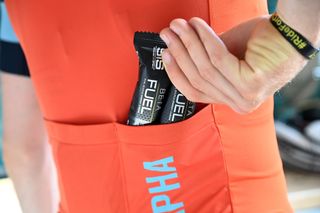
Does this mean that we all need to be consuming 90g to 120g of carbs every time we ride? Maurten’s 320 mix provides 80g carbs per 500ml serving and is formulated to turn into a ‘hydrogel’ when it reaches the stomach, thus enhancing absorption.
Putting in a call to the company’s Herman Reuterswärd and asking about the appropriate application of this high-dosage fuelling, Reuterswärd had this to say: “Maurten is not for moderate intensity exercise or once-a-week cyclists,” he says. “It’s for ambitious performance oriented athletes and people doing intense training sessions. It is aimed at scenarios where you are more likely to be at risk of GI distress.”
A pro rider whose team uses Maurten told me anonymously: “Maurten 320 is not for normal people, it’s for intense racing when you barely have the chance to take your hands off the bars, never mind grab a gel and tear it open.”
James Malone, a scientist at Liverpool Hope University, studies how the body turns carbs into energy. He points out that there are many ingredients that can inhibit carbohydrate absorption, including some artificial sweeteners. Malone’s research also suggests that thicker, more concentrated substances can be harder to absorb. Doesn’t this undermine the ‘hydrogel’ principle behind Maurten? “Ultimately, it’s important to find out what works for you,” says Malone. “That’s likely to come through trial and error. What works for others might not work for you.”
Australian pro rider Tiffany Cromwell (Canyon-SRAM) has been perfecting her fuelling in the women’s pro peloton for over a decade. “The biggest thing to understand is that it’s very individual,” she corroborates Malone’s advice. “Personal preference is important.” Cromwell opts for real food whenever possible. “For training, I make my own banana bread, and I like to use high quality coconut water. Racing is different because it’s about what’s easiest.” Even while racing, Cromwell uses rice cakes as well as gels.
“The timing of fuelling is key,” she adds. “I used to be bad at overtraining and under-fuelling. I’d wonder why I had no energy left at the end of a ride. Now I am much better. In races, as I plan to eat every 30 minutes.” Outside of races, following a routine has helped Cromwell to build positive nutrition habits and make sure she gets enough of the right stuff. “Getting a team chef and a food truck was a game-changer,” she adds. “It means that we all get the food that we need. Nutrition fuels your engine; not getting enough of the right things can be a challenge, especially when you’re away from home.”
Cromwell’s fuelling rescue remedy? “Nothing beats a Mars bar and a can of Coke to crush a hunger flat – it’s your get-out-of-jail-free card.”
Cromwell’s past under-fuelling is a common mistake. Coach Heidi Blunden believes that “95 per cent of cyclists don’t eat enough at the right times, before and during their riding.” Fasted riding is possibly one of the most practised but least understood strategies in cycling. The basic concept is that reducing carbohydrate availability will force the body to burn more fat. “It’s true that fasted training can increase certain metabolic processes including fat metabolism,” says Marc Fell, “but you can also get these adaptations while fuelling well. If you are under-fuelled, you cannot help but reduce the intensity of your training, reducing your power, which in turn reduces the training stimulus.”
So should fasted rides be off the menu completely? “You can train low-carb at low intensity for short periods of time,” says Fell, “but chronic under-fuelling puts stress on the body, and riders tend to eat more after a fasted training session. Whether it’s worth it is questionable.” James Malone is equally sceptical and advises: “The more we train, the better we get at burning fat, irrespective of nutrition.”
In all conversations with the sports scientists, hydration experts, coaches, and athletes, what stood out time and again was the emphasis on taking an individual approach. The ‘crossover’ point at which your body preferences carbs over fat is unique to each individual. The amount you need to eat and drink depends on many variables: your training load, the temperature, how much you sweat and, to a lesser extent, the composition of your sweat. The amount of carbs that you need to perform will depend not only on the training intensity and duration but also on how well your gut can absorb your chosen refuelling substances.
“Each athlete has to find out for themselves the solutions that work best for them,” concludes Lim – and Malone agrees: “Ultimately, it’s less about the product and more about the practice”.
Post ride recovery food: when and what to eat after you’ve ridden
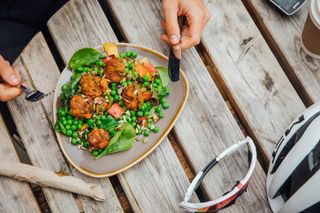
The first 20 minutes after a ride is known to be the optimal refuelling period where nutrients are taken up more efficiently and transported to the muscle stores. Refuelling with real food after cycling with a carbohydrate-rich meal or drink in this period will improve the rate at which your energy stores refill, thus impact directly on how much stored energy you have available for your next ride.
With research indicating that an intake of 1g of carbohydrate per kilogram you weigh during this time is perfect for refuelling, a 70g carbohydrate feed for a 70kg cyclist is perfect. Combining this with 10g of protein will reduce your likelihood of getting injured, assist muscle recovery and reduce muscle soreness and has even been shown to speed up carbohydrate muscle refuelling.
A milk-based drink, a whey or soy protein-enriched smoothie, a jacket potato and beans, or a specialised recovery drink all make good, sensible options. With some of the specialised formulas you can benefit from ingredients such as glutamine and colostrum, two proteins that can provide extra immune support after strenuous training sessions or races.
Check out our guide to the best recovery drinks.
Or here you can find recipes for making your own recovery bars: does either no-bake fruit and oat bar, sweet potato and chocolate bar, or cheese and three seed bar sound any good to you?
If you’re not a whizz in the kitchen, here’s a round up of today’s best recovery bar deals...
Recipes: on-the bike cycling nutrition
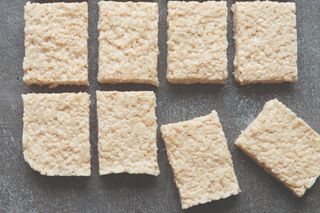
Nutrition for cycling while on the bike can be obtained from easy-to-consume energy gels, energy drinks or energy bars, and the latter could be ones you make yourself.
Fancy making some real food ride snacks, how about…?
Vegan rice cakes
INGREDIENTS
600ml water
400ml thick coconut milk
500g sushi rice
25g sugar
25g coconut oil
5ml vanilla extract
Pinch of salt
50g dark chocolate, chopped
150g mixed nuts and dried fruit
EQUIPMENT
Large saucepan
Lasagne dish, lined with baking paper
1) Combine the water, rice, sugar, coconut milk, coconut oil and vanilla in a heavy-bottomed saucepan with a lid (or rice cooker if you have one).
2) Bring to a boil over medium high heat. Once it starts boiling, cover the pan with the lid and reduce the heat to low.
3) Once the rice is cooked, mix in the chocolate, nuts and dried fruit. Spoon into the lasagne dish and flatten with a spatula. Leave to cool in open air. Once cool, transfer to the fridge to set overnight.
4) The next day, cut the rice cakes into pocket-sized pieces and wrap in foil. Store in the fridge or freezer.
Looking for more on-bike nutrition snacks? Here’s how to make Superseed Flapjacks and Veggie Rice Balls.
Caffeine: good or bad?
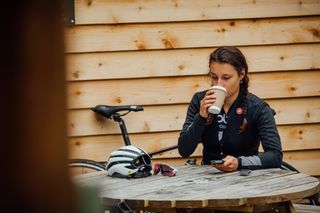
Some people avoid caffeine like the plague and others embrace it for its performance-supporting effects. If you’re a fan, you’ll find most sports physiologists are with you with studies showing that three to six milligrams (mg) of caffeine per kilo of body weight can result in enhanced performance, increased power output and improved mental focus, with larger doses generally offering no additional benefit.
For example, a 60kg cyclist would take between 180-360mg of caffeine – that’s two or three cups of coffee.
Interestingly, caffeine’s effects appear to be negated by the heat, with studies in hotter climates showing no benefit. This may be due to fatigue being limited by thermoregulation in these conditions rather than fuel supply.
If you are thinking of giving a caffeinated drink or gel a try in an event try it in training first. However, it's not for everyone. If you suffer from high blood pressure or a heart condition, caffeine use is not recommended and if you are on any medication, it’s best to check with your doctor before giving it a try.
Good vs bad fats
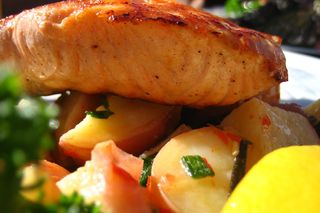
The type of fat you select is critical to health, performance and weight maintenance. Fats are grouped into 'good' fats and 'bad' fats. Good fats include polyunsaturated fats (Omega 3 and Omega 6 fats) and monounsaturated fats (Omega 9 fats).
Whereas saturated fats found in meats and processed foods are to be limited, Omega 3 and 6 fats are vital to maintaining health and are found in nuts, seeds, fish and oils such as flaxseed, borage and starflower oil.
Additional benefits from these fats include a reduction of inflammation in the body, making them great for those with asthma and allergies while also providing a stimulatory benefit to the metabolism, and therefore assisting in weight loss.
Good fats are known to reduce bad cholesterol (LDL) and are therefore an important part of the diet to assist in the prevention of heart disease. Aiming for around 20g of good fat per day is a great strategy for health support without the risk of adding too many calorific fats to the diet.
Vitamins and minerals: how to get enough
There are two main types of vitamins: fat-soluble and water-soluble ones. The fat-soluble vitamins A, D, E and K are stored in the body. The water-soluble ones, however, are not stored in the body and therefore are needed in the diet every day. Minerals such as calcium, iron and zinc are also needed daily, but only in very small quantities.
These vitamins and minerals can be found in a variety of foods. The NHS recommendation of five pieces of fruit and vegetables per day is aimed to assist in the daily achievement of these vitamins and minerals along with sufficient fibre intake. Selecting a rainbow of colours and aiming for darker-coloured fruits and vegetables is recommended.
To ensure deficiencies don’t develop, especially when training regularly, a good multivitamin supplement is a wise health and performance booster for cyclists. However, avoid mega-dosing on nutrients unless used as a short-term treatment (for example in the case of vitamin C and zinc use during a cold to reduce severity and duration of symptoms).
Glucose tracking: the next big thing in cycling nutrition?
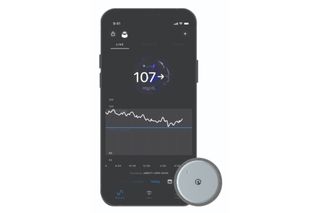
What’s going to be ‘the next big thing’ in training tech for cycling that we all start to adopt? Well, nutrition-wise it could well be Supersapiens’ biosensor which keeps tabs on blood glucose levels, providing real-time data to athletes via a mobile app.
Why is it interesting?
Since glucose and energy is key to performance, this may be a game-changer in optimising performance. It’s causing such a storm that the UCI has banned it from competition. UCI innovations manager Mick Rogers told CW that the ban was aimed at preventing inequality between those who can and can’t afford it, thus avoiding a Formula One type scenario where tech determines who wins.
What are the key benefits of seeing your blood glucose level minute to minute?
In training, you can see real-time responses to your nutrition and ensure you have enough energy available to perform.
Outside training, you can see how your body responds to food. Beyond food, you may be able to see how other factors might impact blood glucose e.g. sleep, recovery etc.
What are the drawbacks?
Blood glucose doesn’t account for stored carbs (muscle glycogen), so it’s not a complete picture of how your body uses energy. It takes time, effort and expertise to understand the data and gain actionable insights from it. Many variables affect energy availability, blood glucose level and performance; it may be hard to untangle correlation and causation.

Thank you for reading 20 articles this month* Join now for unlimited access
Enjoy your first month for just £1 / $1 / €1
*Read 5 free articles per month without a subscription

Join now for unlimited access
Try first month for just £1 / $1 / €1
Deena Blacking is a cycling coach and sports consultant at drivetrain.cc
- Anna Marie AbramFitness Features Editor
-
 Bonnie Tu, the most powerful woman in bicycling, retires after more than 30 years in the industry
Bonnie Tu, the most powerful woman in bicycling, retires after more than 30 years in the industry'Her unwavering passion transformed the cycling industry and empowered countless women to chase their dream,' says Liv in tribute
By Anne-Marije Rook Published
-
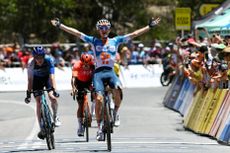 'It used to annoy me when people said 'enjoy it', now cycling is my job, I understand': Oscar Onley on his rise through the ranks
'It used to annoy me when people said 'enjoy it', now cycling is my job, I understand': Oscar Onley on his rise through the ranksThe 22-year-old talks through his beginnings as a cyclist, turning pro with Picnic PostNL and what’s next in 2025.
By Tom Thewlis Published
-
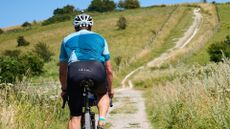 'My riding companion proceeded to fragment into countless tiny particles and dissolve into the night sky — I was hallucinating': Inside a 500km ultra ride
'My riding companion proceeded to fragment into countless tiny particles and dissolve into the night sky — I was hallucinating': Inside a 500km ultra rideKeen to test the limits of his well-matured endurance, Steve Shrubsall hurls himself headlong into a 500km ultra-endurance adventure across England's North and South Downs
By Stephen Shrubsall Published
-
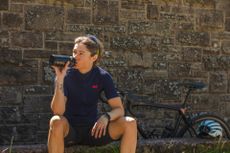 Hot weather cycling: 6 tips to help you keep your cool
Hot weather cycling: 6 tips to help you keep your coolA spell of hot weather needn't stop you enjoying your riding, as long as you take some precautions to prevent over-heating and dehydration
By Anna Marie Abram Published
-
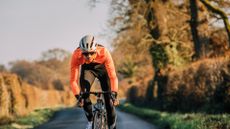 21 ways to get your season off to a flying start
21 ways to get your season off to a flying startMotivation is key: achievable, aspirational goals with clear checkpoints is a great place to start. Structured training, bike servicing and joining a club will all help set you on the right trajectory, too
By Charlie Allenby Published
-
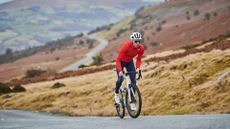 Eight-step guide to crafting your achievable goal this year, according to a cycling coach
Eight-step guide to crafting your achievable goal this year, according to a cycling coachHow to come up with a target you can hit - plus some pointers on how to stay on track
By Chris Marshall-Bell Published
-
 Why is everyone talking about Zone 2 training? Tadej Pogačar, or rather his coach, is responsible - here’s why
Why is everyone talking about Zone 2 training? Tadej Pogačar, or rather his coach, is responsible - here’s whyThe cacophony of praise for Zone 2 training of late left Chris Sidwells scratching his head. So he decided to find out what all the fuss was about
By Chris Sidwells Published
-
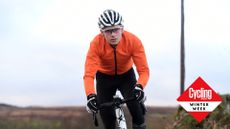 Seven benefits of riding outdoors - which you’ll miss out on if you train inside all winter
Seven benefits of riding outdoors - which you’ll miss out on if you train inside all winterAs with most things in life, there is a balance to be struck…
By Andy Turner Published
-
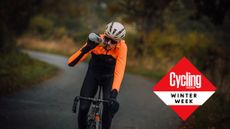 Winter fueling: how to match your cycling nutrition to the demands of cold weather riding
Winter fueling: how to match your cycling nutrition to the demands of cold weather ridingGetting the most out of your winter training means making sure you are optimally fuelled for every ride - here's what you need to know about the specific demands of cold season nutrition
By Joe Laverick Published
-
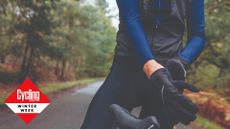 Suffering from numb feet or hands when cycling? Here's how to combat the cold
Suffering from numb feet or hands when cycling? Here's how to combat the coldYour extremities are the first to suffer when the temperture drops. Here's how to avoid painfully cold hands and feet
By Hannah Bussey Published